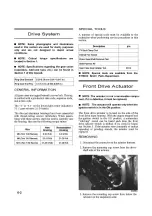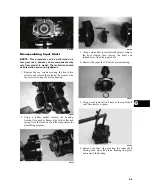
2. Select the OHMS position on the tester and con-
nect the red tester lead to the lavender/red wire;
then move the gear shift lever to the R (reverse)
position. The meter must read less than 1 ohm.
3. Move the red tester lead and shift lever in turn to
the light green/red wire and N (neutral) position,
white/black wire and H (high) position, and
white/red wire and L (low) position. The meter
must read less then 1 ohm in all positions. If not,
the gear shift linkage must be adjusted (see Sec-
tion 2) or the switch must be replaced.
Stator Coil
VOLTAGE
(AC Generator - Regulated Output)
1. Set the meter selector to the DC Voltage position.
2. Connect the red tester lead to the positive battery
post; then connect the black tester lead to the nega-
tive battery post.
3. With the engine running at a constant 3000 RPM
(with the headlights on), the meter must show 14-
15.5 DC volts.
CAUTION
Do not run the engine at high RPM for more than
10 seconds.
NOTE: If voltage is lower than specified, test
charging coil - no load.
VOLTAGE (Charging Coil - No
Load)
The connector is the y e l l o w three-pin one on the
right side of the engine just above the starter motor.
NOTE: Test the engine-side of the connector.
1. Set the meter selector to the AC Voltage position.
2. Test between the three yellow wires for a total of
three tests.
3. With the engine running at the specified RPM, all
wire tests must show 60 AC volts.
CAUTION
Do not run the engine at high RPM for more than 10
seconds.
NOTE: If both charging coil tests failed, check
all connections, etc., and test again. If no voltage is
present, replace the stator assembly.
RESISTANCE (Charging Coil)
CAUTION
Always disconnect the battery when performing
resistance tests to avoid damaging the multimeter.
1. Set the meter selector to OHMS position.
2. Test between the three yellow wires for a total of
three tests.
3. The meter reading must be within specification.
RESISTANCE (Trigger Coil)
CAUTION
Always disconnect the battery when performing
resistance tests to avoid damaging the multimeter.
1. Disconnect the gray four-pin connector on the right
side of the engine just above the starter motor.
2. Set the meter selector to the OHMS position.
3. Connect the red tester lead to the green/white
wire; then connect the black tester lead to the
blue/yellow wire. The meter reading must be
within specification.
PEAK VOLTAGE
NOTE: All of the peak voltage tests should be
made using the Fluke Model 73 Multimeter with
Peak Voltage Reading Adapter. If any other type of
tester is used, readings may vary due to internal
circuitry.
NOTE: The battery must be at full charge for
these tests.
Trigger Coil
1. Set the meter selector to the DC Voltage position.
2. Connect the red tester lead to the green/white
wire; then connect the black tester lead to the
blue/yellow wire.
3. Crank the engine over using the electric starter.
4. The meter reading must be within specification.
Starter Relay
1. Remove the seat; then using the multimeter set to
the DC Voltage position, check the relay as fol-
lows.
2. Connect the red tester lead to the positive battery
terminal; then connect the black tester lead to the
starter cable connection on the starter relay. The
meter must show battery voltage.
5-9
Summary of Contents for MXU 450i
Page 17: ...Oil level stick...
Page 23: ...Low range High range Neutral Reverse...
Page 25: ...1 mm 0 039 in...
Page 126: ...A B...
Page 127: ...LCD Gauge Connector LCD Gauge Connector...
Page 134: ...9 4 NOTES...
Page 135: ......
















































